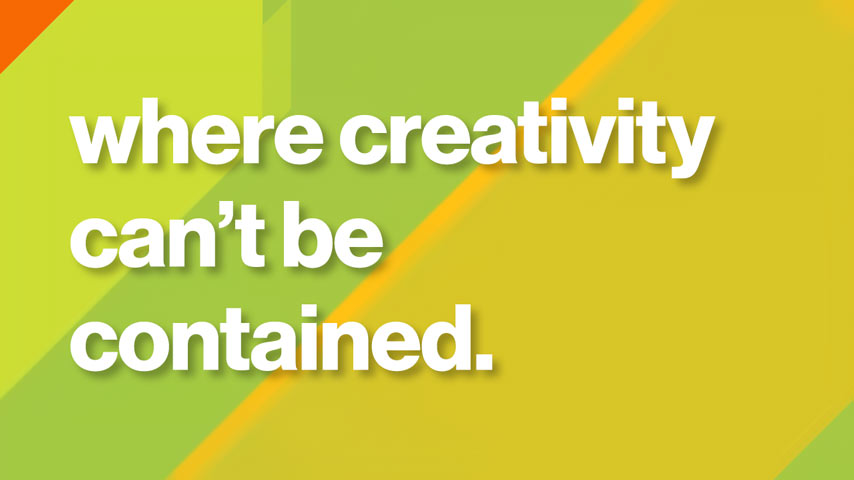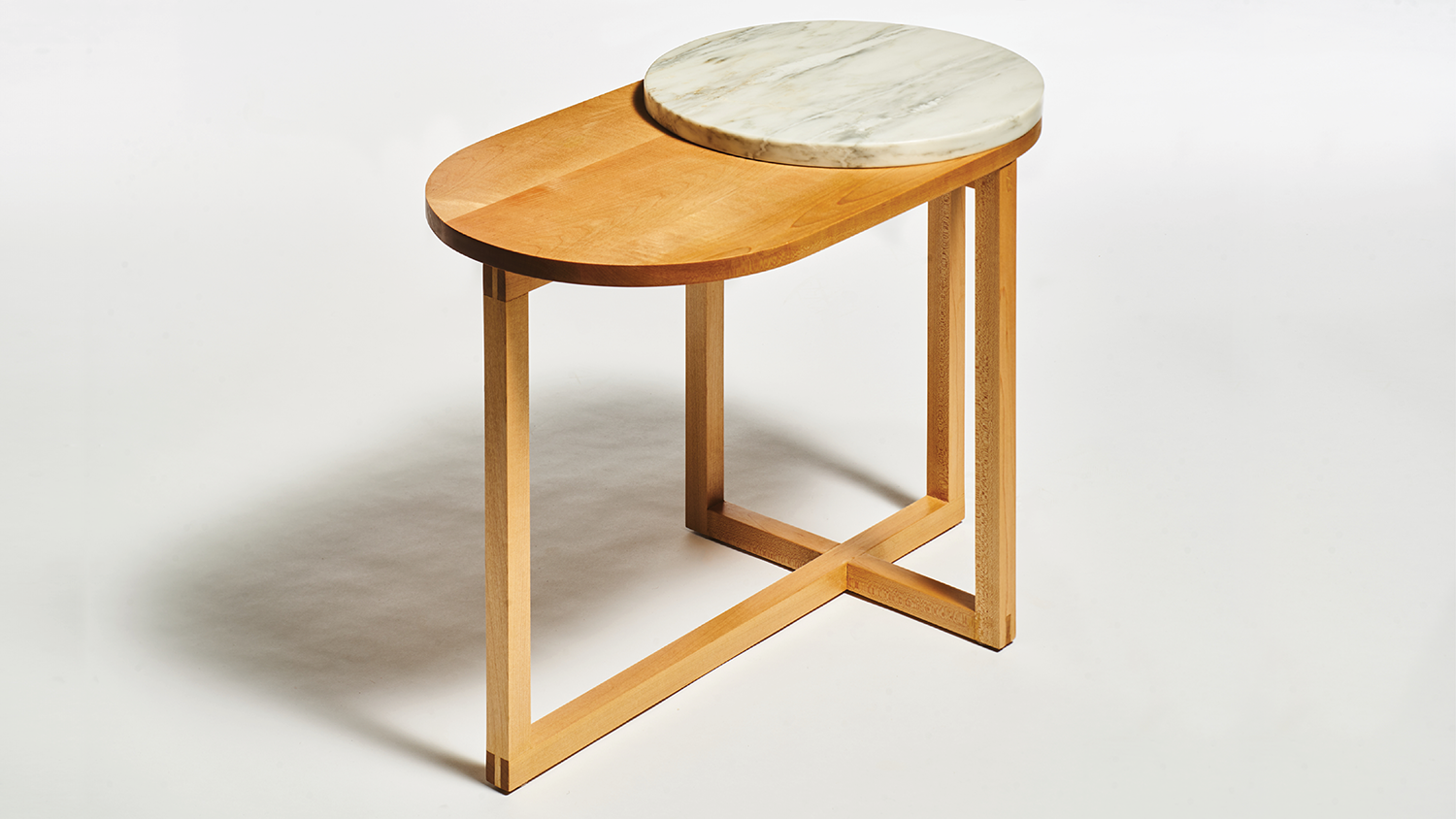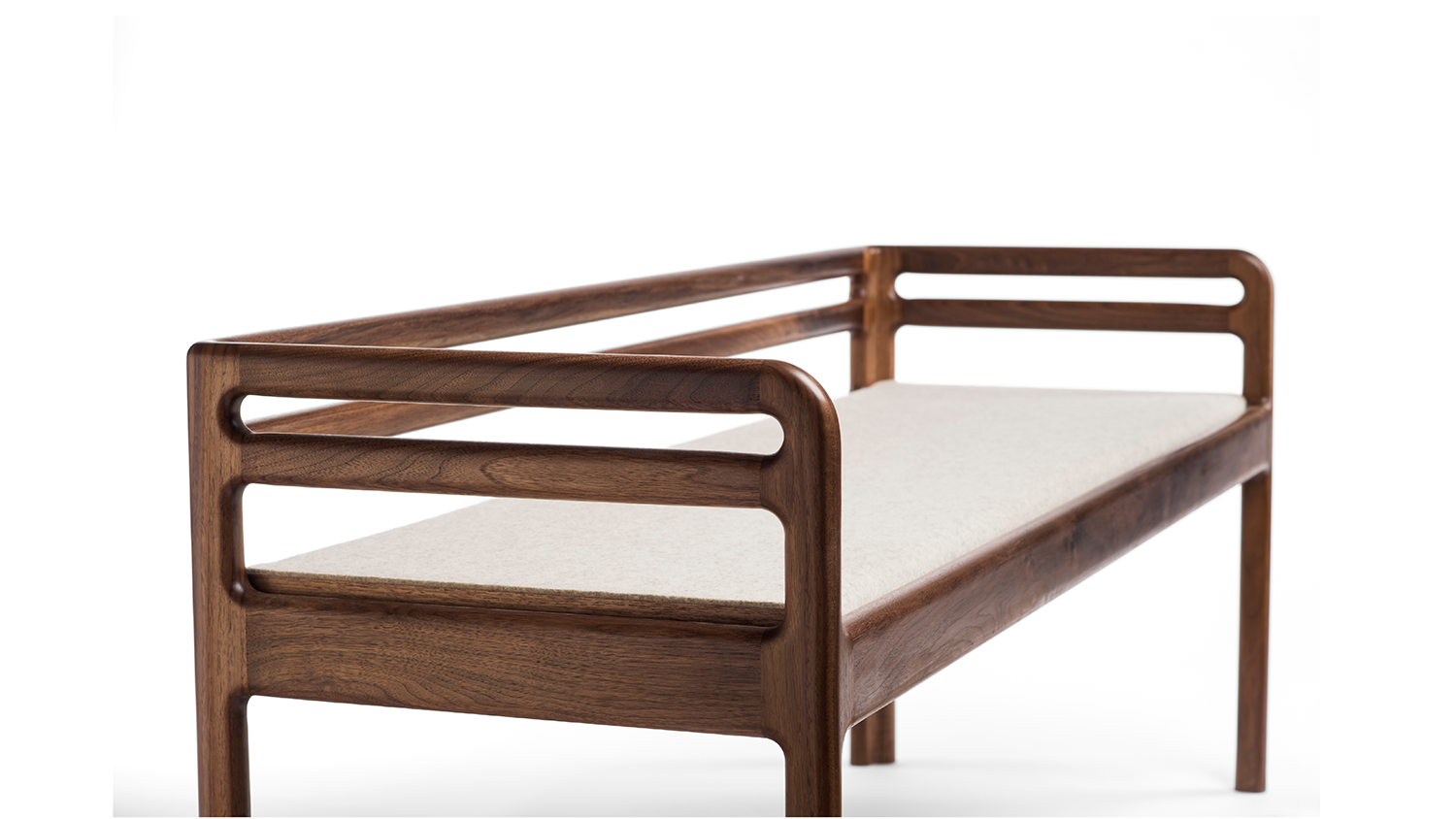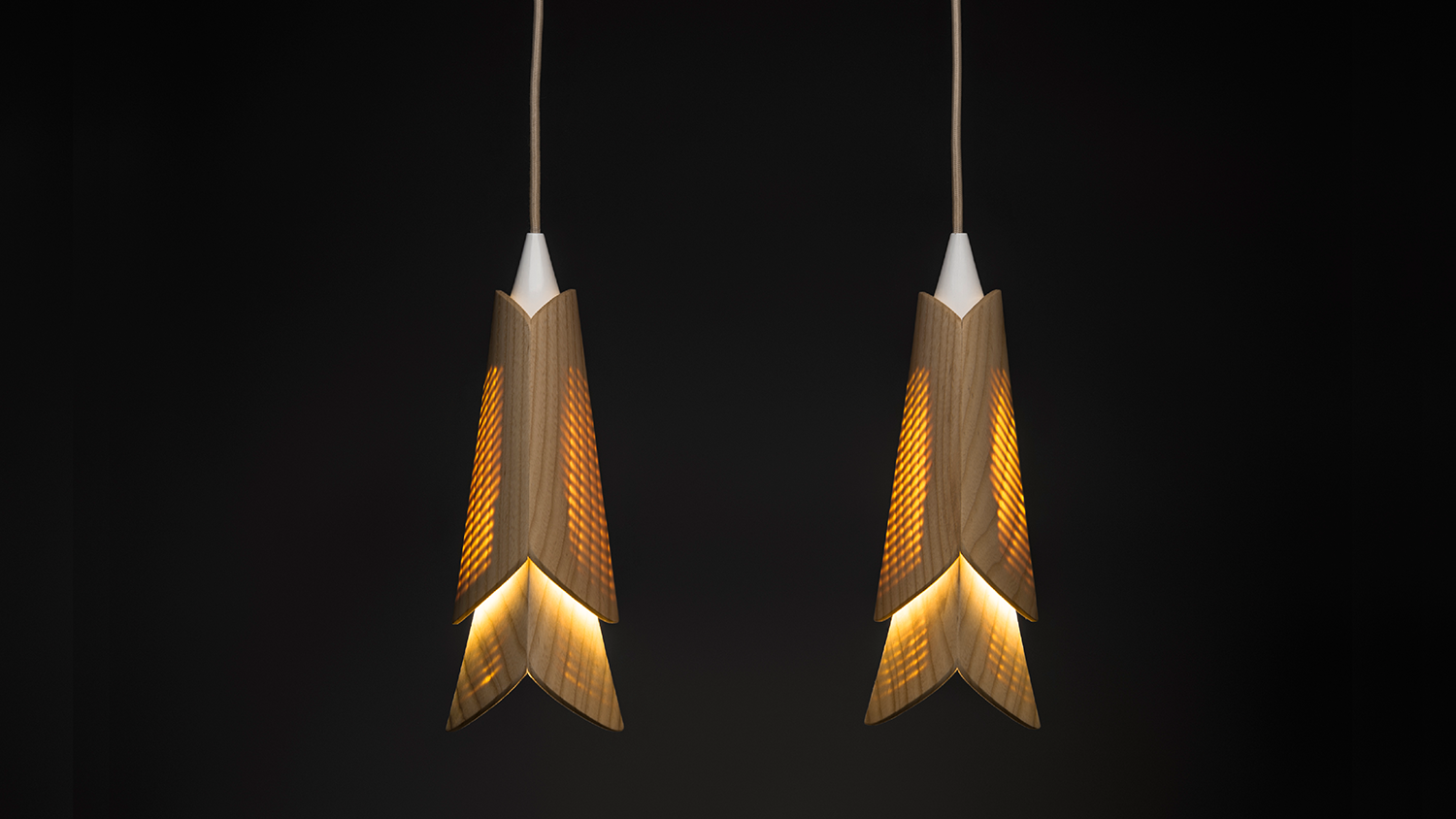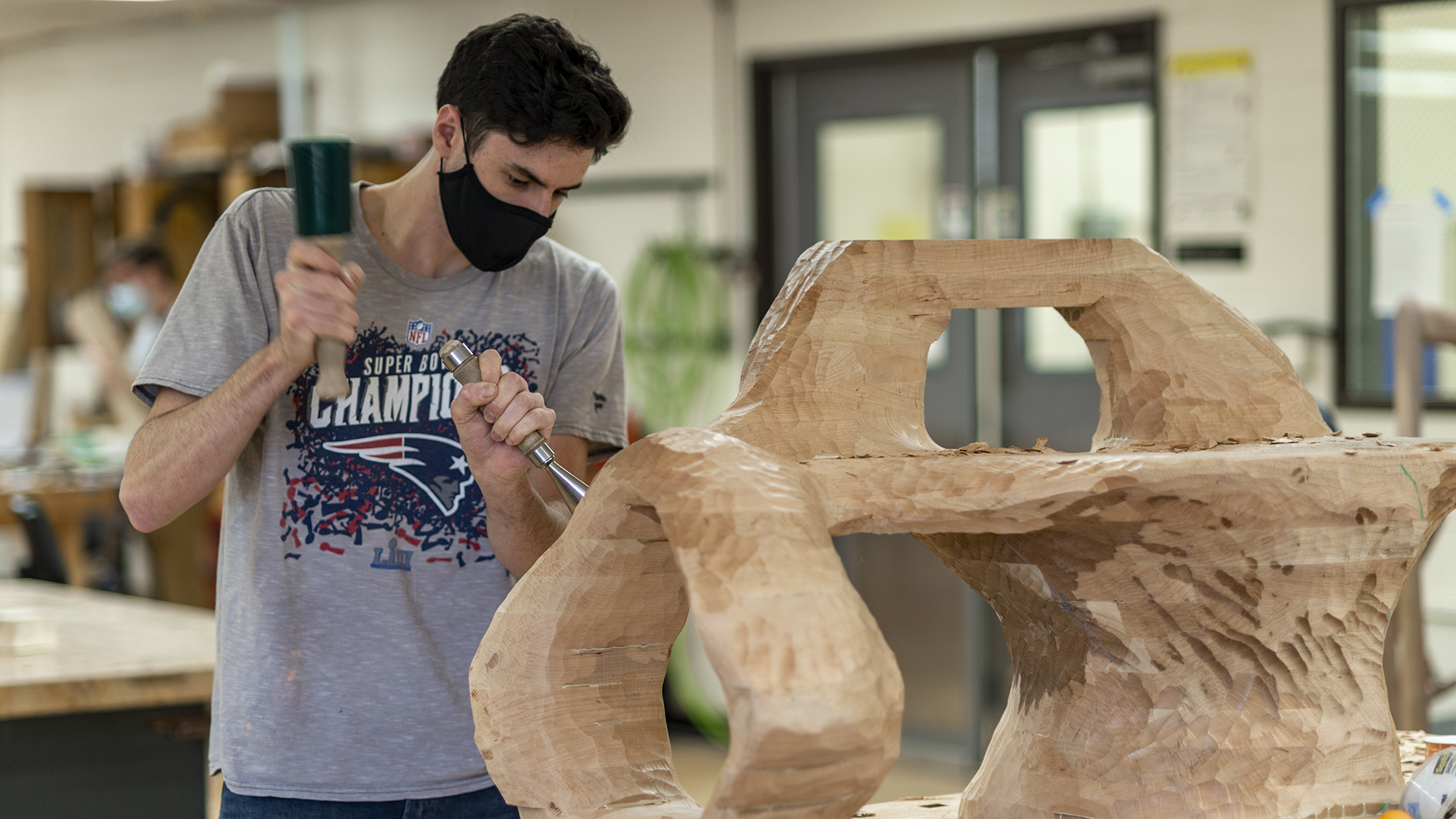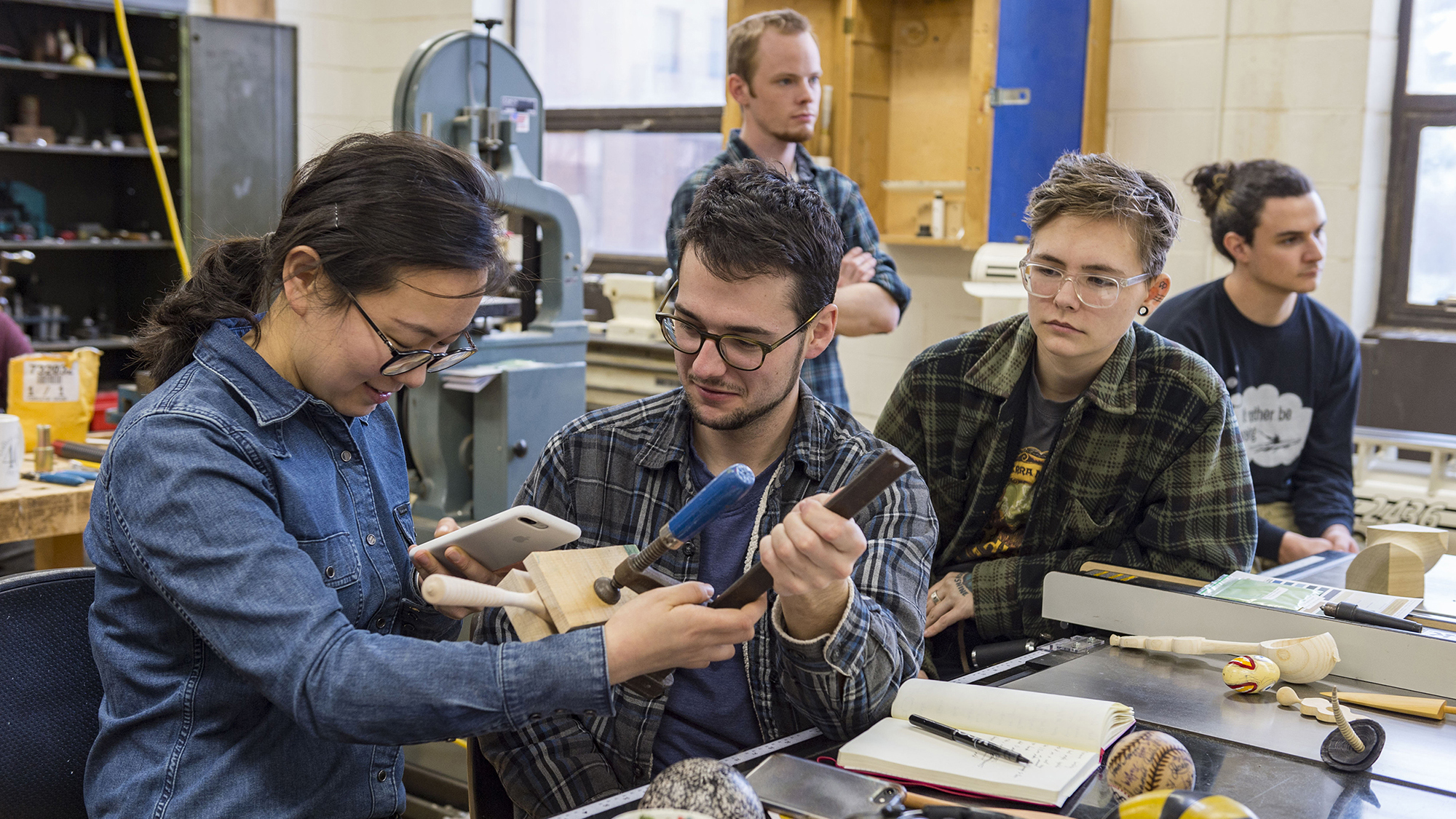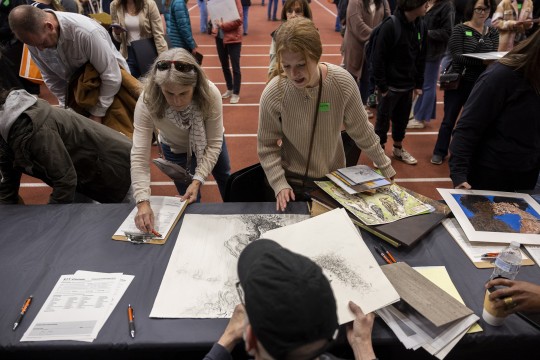Furniture Design Associate in Occupational Studies Degree


Furniture Design
Associate in Occupational Studies Degree
- RIT /
- Rochester Institute of Technology /
- Academics /
- Furniture Design AOS
Request Info about undergraduate study
Visit
Apply
School for American Crafts
Overview for Furniture Design AOS
An intensive course of study combining foundations in art and design with two years of study in woodworking and furniture design. For individuals not seeking the BFA or MFA degree, the associate degree will provide you with many of the fundamentals to begin a career in woodworking and furniture design.
The AOS degree in furniture design is a highly-focused, two-year course of study. Students learn how to use and care for basic hand tools and begin to explore the technical and visual potential of wood. Over the two-year experience, increasingly sophisticated techniques and design concepts are introduced. Students complete courses in two-dimensional design, three-dimensional design, freehand drawing, technical drawing, furniture history, and crafts business practices.
Featured Work
Tables, Chairs and Wall Decor
Yichi Cheng
Seating Projects
Jared Alon
Lights
Will Barstow
Featured Profiles
Why You Belong in RIT's College of Art and Design
Todd Jokl, Mari Jaye Blanchard, Melissa Dawson, Clay Patrick McBride
Get an in-depth look at RIT's College of Art and Design from our faculty and students. Let us share with you how our community of artists pushes the boundaries of creativity and innovation. And...
Curriculum for 2023-2024 for Furniture Design AOS
Current Students: See Curriculum Requirements
Furniture Design, AOS degree, typical course sequence
| Course | Sem. Cr. Hrs. | |
|---|---|---|
| First Year | ||
| CWFD-213 | Introduction to Woodworking and Furniture Design This is a course required for majors and open to non-majors at RIT, covering beginning woodworking techniques, and the design process as it relates to the material. Topics include the use of select hand tools, woodworking power tools, the basic properties of wood as a material, and the fundamental processes of wood fabrication. The course includes prescribed projects based on in-class contact hours. In this course students will develop the fundamentals of working with wood. **Fee: There is a materials fee required for this course and an additional course fee applied via student account. ** (Prerequisites: FDTN-131 or CWFD-124 or equivalent course.) Studio 6 (Fall or Spring). |
3 |
| CWFD-124 | Woodworking / Furniture Design Studio Survey This open elective course will introduce students to the furniture design studio and to wood as creative material. The content of the course will focus on the introduction of tools and techniques in woodworking and the creative design process. Students will learn basic skills and safety procedures for using hand tools and machine tools. **Fee: There is a materials fee required for this course and an additional course fee applied via SFS bill. See course notes for course fee information.** Studio 5 (Fall or Spring). |
3 |
| FDTN-111 | Drawing I This course is an introduction to the visualization of form, thought, and expression through the drawing process and is the first of two sequential courses that are the foundation of the drawing curriculum in the College of Art and Design. Concepts are introduced by lectures, discussions, and demonstrations which are designed to provide a broad introductory experience. Students will experiment with a wide variety of media, tools, techniques and subjects to develop drawing and problem-solving skills related to form and composition. The focus of the course is to provide awareness of the full range of ways in which drawing is used as a tool for both self-expression and communication. **Fee: A materials fee is required for this course, and an additional course fee applied via student account** Studio 6 (Fall or Spring). |
3 |
| FDTN-121 | 2D Design I This course is an introduction to the basic elements and principles of two-dimensional design and is foundational to the College of Art and Design curriculum. The focus of this course is the development of visual and verbal vocabularies as a means of exploring and understanding two-dimensional design. Students will engage with a wide variety of media, tools, and techniques to develop skills while delving into the theoretical and experimentational processes of contemporary art and design. The exploration of historical and cultural themes and concepts intertwined with aspects of personal interpretation and experience will be included in the curriculum. **Fee: A materials fee is required for this course, and an additional course fee applied via student account** Studio 6 (Fall or Spring). |
3 |
| FDTN-131 | 3D Design I This course presents a progressive study in terminology, visual principles, exploration, concept generation, process, and techniques of three-dimensional design and is foundational to the College of Art and Design curriculum. Using hands-on problem solving, student will develop an informed understanding of the three-dimensional form and space with an emphasis on the elements and principles of visual design and their function as the building blocks and guidelines for ordering a three-dimensional composition. A heightened awareness of form and space will be developed through lecture, assigned projects, and critiques. Students will also develop a personal awareness of problem seeking and solving, experimentation and critical analysis. **Fee: A materials fee is required for this course, and an additional course fee applied via student account** Studio 6 (Fall or Spring). |
3 |
| FDTN-141 | 4D Design 4D Design introduces students to the basic concepts of art and design in time and space. The course explores elements of moving images such as continuity, still and moving image editing, transitions and syntax, sound and image relations, and principles of movement. Computers, video, photo, sound and lighting equipment are used to create short-form time-based work relevant to students in all majors and programs required to take this course. The course addresses the both historical conventions of time in art and recent technological advances, which are redefining the fields of Fine Art and Design. In focusing on the relations between students' spacing and timing skills, 4D Design extends and supplements the other Foundation courses, and prepares students for further work with time-based media. (Undergraduate Art and Design) Lab 5 (Fall, Spring). |
3 |
| STAR-503 | CAD Drawing This class covers basic CAD (computer-aided design) drawing for both design and presentation. Topics covered will include a broad range of drawing types, three-dimensional modeling, and presentation techniques. The course includes demonstrations, lectures, group-discussions, projects, and presentations. At the completion of this course students will use skills obtained in CAD orthographic drawing and 3-dimensional modeling to refine and present ideas and projects. Lec/Lab 5 (Fall or Spring). |
3 |
| YOPS-10 | YOPS-10 RIT 365: RIT Connections RIT 365 students participate in experiential learning opportunities designed to launch them into their career at RIT, support them in making multiple and varied connections across the university, and immerse them in processes of competency development. Students will plan for and reflect on their first-year experiences, receive feedback, and develop a personal plan for future action in order to develop foundational self-awareness and recognize broad-based professional competencies. (This class is restricted to incoming 1st year or global campus students.) Lecture 1 (Fall, Spring). |
0 |
CAD Studio Electives† |
3 | |
| Choose one of the following: | 3 |
|
| FDTN-112 | Drawing II From observation of still life, the figure, and interior/exterior spaces, Drawing II continues to build on the foundation of the College of Art and Design drawing curriculum. This course continues the study of traditional drawing mediums and techniques while introducing color and a selection of contemporary practices and tools through examining organic and geometric mark making, form, space and value. Core concepts are introduced by lectures, discussions, and demonstrations; the primary assessment method of course work will be through critiques which facilitate growth of both a visual and verbal vocabulary. The focus of the course is to provide awareness of the full range of ways in which drawing is used as a tool for self-expression, communication and continued development of creative practice and problem solving. **Fee: A materials fee is required for this course, and an additional course fee applied via student account** (Prerequisites: FDTN-111 or ITDI-211 or equivalent course.) Studio 6 (Fall or Spring). |
|
| FDTN-212 | Drawing II Workshop: Topics This course is an investigation of the visualization of form, thought and expression through the drawing process. This workshop provides students with the opportunity to learn more about a particular experience in drawing while still covering required foundation elements. Different topics may be taken in the same semester. Topics may only be taken once. Concepts are introduced by lectures, discussions, demonstrations, research and assigned projects.. The focus of the course is to provide awareness of the full range of ways in which drawing is used as a tool for both self-expression and communication. (Prerequisites: FDTN-111 or ITDI-211 or equivalent course.) Studio 6 (Spring). |
|
| Choose one of the following: | 3 |
|
| FDTN-132 | 3D Design II This is the second-semester of a sequential course. The focus is on composing three-dimensional form and its relationship to space. Students will build on their prior term experiences, which include the introduction to 3D principles, materials, and building processes. Students will develop the sophisticated skill of conceptualization. More advanced problems will be assigned and students will have the opportunity to explore a wide range of material and process possibilities for their resolution. A heightened awareness of idea development and design research will be explored. Inclusion of 21st century themes in the arts of social cultural and community. (Prerequisites: FDTN-131 or equivalent course.) Studio 6 (Spring, Summer). |
|
| FDTN-232 | 3D Design II Workshop: Topic This workshop provides students with the opportunity to learn more about 3D compositions within a more open and experimental realm while still covering the core Foundation concepts. Different topics may be taken in the same semester. Topics may only be taken once. The focus is on composing three-dimensional form and its
relationship to space. Material exposure will be determined by the topic’s instructor. (Prerequisites: FDTN-131 or equivalent course.) Studio 6 (Spring). |
|
| Second Year | ||
| CWFD-506 | Furniture Design: Table Design and Construction This course covers intermediate woodworking techniques associated with furniture design and construction. Students will investigate the functional and aesthetic considerations of table design through ideation and conceptual development. Topics include the properties of wood as a material, design development through drawing and model-making, the safe use and care of hand tools such as chisels and saws, portable power tools, and the use of stationary power tools. Students will be introduced to wood joinery best suited for table construction. **Fee: A materials fee is required for this course and an additional course fee will be applied via student account** (Prerequisites: CWFD-213 or CWFD-124 or CWFD-MN or WOOD-AOS students or equivalent course.) Studio 6 (Fall or Spring). |
3 |
| CWFD-507 | Furniture Design: Bench Design and Construction This course covers intermediate woodworking techniques associated with furniture design and construction. With a focus on aesthetics, structure, and functionality, students will design and construct furniture for seating such as stools and benches. Topics covered will include intermediate joinery techniques, lathe turning, hand and power shaping, and the safe use of the multi-router, router table and rotary carving tools. These processes will foster a focus on craftsmanship, technical knowledge and design development. **Fee: There is a materials fee required for this course and an additional course fee applied via student account. ** (Prerequisites: CWFD-213 or CWFD-124 or CWFD-MN or WOOD-AOS students or equivalent course.) Studio 6 (Fall or Spring). |
3 |
| CWFD-511 | Furniture Design: Wood Carving This course will provide students with fundamental techniques necessary to design and fabricate refined hand carved vessels and other wooden objects. Participants in this course will gain an understanding of the inherent properties of wood, identifying assets and limitations of the material as they design and build. Students will develop skills to formalize individual design ideas for presentation, planning and construction. Topics will include lumber selection, the safe and proper use of machinery and portable power tools, the care and use of gouges, spokeshaves, and other sharp-edged hand tools, as well as sanding and wood finishing, and will support the focus on craftsmanship, technical knowledge and design development. **Fee: There is a materials fee required for this course and an additional course fee applied via SFS bill. See course notes for course fee information. ** (Prerequisites: CWFD-213 or CWFD-124 or CWFD-MN or WOOD-AOS students or equivalent course.) Studio 6 (Fall or Spring). |
3 |
| CWFD-512 | Furniture Design: Box and Cabinet Design and Construction This course covers the techniques associated with the design and construction of wooden boxes and cabinets. Students will design and build a number of functional pieces giving careful consideration to the inherent properties of the material. Course topics will include lumber selection and processing, joinery layout and corner joint construction, as well as the safe use of hand and power tools. The class will also introduce lid, drawer, and hinging options, and intermediate hand finishing techniques. At the completion of this course, students will have the technical knowledge and design development to create artwork with the highest level of craftsmanship. **Fee: A materials fee is required for this course and an additional course fee will be applied via student account** (Prerequisites: CWFD-213 or CWFD-124 or CWFD-MN or WOOD-AOS students or equivalent course.) Studio 6 (Fall or Spring). |
3 |
| STAR-311 | Ideation and Series This course will examine appropriate skills and strategies to generate ideas and develop them effectively. Through personal and group generative idea exercises, journaling and research students will explore individual ideas and personal interests to produce a final series of creative works. (Prerequisites: FDTN-141 or equivalent course or students enrolled in the WOOD-AOS program.) Studio 6 (Fall or Spring). |
3 |
| STAR-411 | Business Practices for Artists (WI-PR) This course is devoted to business issues that artists must address including building and maintaining a portfolio, pricing and marketing strategies and public relations. Financial organization and communication skills are highlighted as are networking skills for the advancement of an artist’s work. (Prerequisites: (STAR-311 or CCER-302 or CCER-512 or CWFD-302 or CGLS-302 or CMTJ-302 or equivalent course and completion of First Year Writing (FYW) requirement) or student standing in WOOD-AOS.) Lecture 3 (Fall). |
3 |
| STAR-401 | Senior Capstone This course will focus on the production and exhibition of a representative body of artwork. Students will participate in an articulated process of making, engaging in comprehensive research that expands and supports their work, developing a rationale for the use of media and process, creating sketches and models, and the refining work through critiquing and editing. All of this will culminate in the professional presentation of oral, written, and visual work that contextualizes the students’ positions within contemporary artistic practice. Students will also be involved in every aspect of their senior shows from creating the work to installing the exhibition and preparing marketing materials. (Prerequisites: STAR-311 or equivalent course.) Studio 6 (Spring). |
3 |
Art History Electives* |
6 | |
CAD Studio Electives† |
3 | |
| Total Semester Credit Hours | 60 |
|
Please see Wellness Education Requirement for more information. Students completing Associate's degrees are required to complete one Wellness course.
* Art History electives are non-studio courses searchable in SIS with the Art History attribute of ARTH.
† CAD Studio Electives are any College of Art and Design course with a lab or studio component.
Latest News
-
November 6, 2023
![A student has her artwork reviewed by faculty member Don Arday.]()
Prospective students explore RIT art and design programs at National Portfolio Day event
The College of Art and Design welcomed 226 young artists to campus for its National Portfolio Day event, where prospective students met one-on-one with faculty about their artwork and different programs.
-
October 4, 2022
![An overhead view of a student getting their portfolio reviewed by RIT faculty.]()
RIT welcomes prospective students for National Portfolio Day
RIT's College of Art and Design faculty, along with those at 25 other top art and design schools, reviewed students' portfolios as they prepared their artwork for the college admissions process.
-
November 6, 2019
![An overhead photo of RIT's National Portfolio Day.]()
Hundreds attend RIT's National Portfolio Day
In support of the college admission process, prospective students from around the country received portfolio reviews from RIT faculty and reps from other leading art and design colleges.











